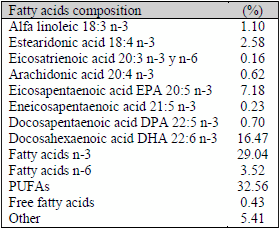Influence of fish oil in the concentration of conjugated linoleic acid and omega 6 and 3 in buffalo milk
The aim of this research work was to investigate the influence of fish oil supplementation on the concentration of conjugated linoleic acid (CLA) and omega 6 and 3 in samples of buffalo milk. A total of 24 female buffaloes separated at random into three groups were fed for 49 days with: natural pasture (group I), supplemented with 70mL of fish oil (group II) and 140mL of fish oil (group III). In the experiment the concentration of CLA showed differences (P<0.05) among the three groups, with a maximum of 7.14mg/g fat in group II. No significant differences were found in omega-6 among the three groups. The highest value of 3.82mg/g fat corresponded to group I, whicht had not been supplemented with fish oil. Significant differences were observed in omega 3 (P<0.05) in groups II and III with respect to group I. The highest average value of 2.42mg/g fat was obtained in group III. The closest relationship omega 6/3 (1.37:1) was observed in group III. As a result, the diets of groups II and III, which included fish oil, increased significantly the content of CLA and omega 3 with reductions in levels of omega 6.
Keywords: Bubalus bubalis, milk, CLA, Omega 6 and 3, fish oil





BELURY, M.A. Dietary conjugated linoleic acid in health: Physiological effects and mechanisms of action. Annu. Rev. Nutr., v.22, p.505-531, 2002.
BERGAMO, P.; FEDELE, E.; IANNIBELLI, L. et al. Fat-soluble vitamin contents and fatty acid composition in organic and conventional Italian dairy products. Food Chem., v.82, p.625-631, 2003.
CALDEIRA, L.A.; FERRAO, S.P.B.; FERNANDES, S.A.A. et al. Lipid profile of Murrah buffalo milk. Red. Vet., v.21, supl. 1, p.567-568, 2010.
CALDER, P.; DAVIS, J.; YAQOOB, P. et al. Dietary fish oil suppresses human colon tumour growth in athymic mice. Clin. Sci., v.94, p.303-311, 1998.
CANNIZZO, F.; BROITMAN, S. Postpromotional effects of dietary marine or safflower oils on large bowel on pulmonary implants of CT-26 in mice. Cancer Res., v.49, p.4289-4294, 1989.
CHILLIARD, Y.; FERLAY, A.; MANSBRIDGE, R.M. et al. Ruminant milk fat plasticity nutritional control of saturated, polyunsaturated, trans and conjugated fatty acids. Ann. Zootech., v.49, p.181-205, 2000.
FEDELE, E.; IANNIBELLI, L., MARZILLO, G. Conjugated linoleic acid content in milk and mozarella cheese from buffalo feed with organic and traditional diet. In: WORLD BUFFALO CONGRESS. 6., Maracaibo. Proceedings IV World Buffalo Congress, Maracaibo. Venezuela. 2001. p.404-409.
GAGLIOSTRO, G.A. Manejo nutricional para la producción de leches de vaca y de cabra con alto impacto sobre la salud humana. Area de Investigación en Producción Animal. Ed. INTA- Balcarce y Facultad de Ciencias Agrarias UNMDP (Mar del Plata, Argentina). 2004. 84 p.
HA, Y.L.; STORKSON, J.; PARIZA, M.W. Inhibition of benzo(a)pyrene-induced mouse forestomach neoplasia by conjugated dienoic derivatives of linoleic acid. Cancer Res., v.50, p.1097-1101, 1990.
IP, C.; SING, M.; THOMPSON, H.J.; SCIMECA, J.A. Conjugated linoleic acid suppresses mammary carcinogenesis and proliferative activity of the mammary gland in the rat. Cancer Res. v.54, p.1212-1215, 1994.
INFOSTAT, 2009. InfoStata versión 2009. Grupo Infostat, Fac. Cs. Agrarias, Universidad Nacional de Cordoba, Argentina
ISO 15304. Animal and vegetable fats and oils- Determination of the content of trans fatty acid isomers of vegetable fats and oils – Gas chromatographic method. 2002.
On line: www.iso.org/iso/iso_catalogue/catalogue_tc/catalogue _detail.htm.
LEE, K.N.; KRITCHEVSKY, D.; PARIZA, M.W. Conjugated linoleic acid and atherosclerosis in rabbits. Atherosclerosis. v.108, p.19-25, 1994.
MAIA, M.R.G.; CHAUDHARY, L.C.; BESTWIICK, C.S. et al. Toxicicty of unsaturated fatty acids to the biohydrogenating ruminal bacterium, Butyrivibrio fibrisolvens. BMC Microbiology, v.10, p.52, 2010.
MEDEIROS, S.R. Ácido linoléico conjugado: teores nos alimentos e seu uso no aumento da produção de leite com mayor teor de proteína e perfil de acidos graxos modificados. USP. 2002. 98f. Tese (Doutorado em Agronomia). Escola Sup.de Agricultura Luia de Queiroz. USP.
MENOTTI, A.; KROMHOUT, D.; BLACKBURN, H. et al. Food intake patterns and 25- year mortality from coronary heart disease: cross-cultural correlation in the seven countries study. The seven countries study research group. Eur. J. Epidemiol., v.15, p.507-515, 1999.
NATIONAL Research Council (NRC). Carcinogenesis and anticarcinogenesis in the human diet. National Academy Press. 1996. 242p.
NICOLOSI, R.J.; COURTEMANCHE, K.V.; LAITINEN, L. et al. Effect of feeding diets enriched in conjugated linoleic acid on lipoproteins and aortic atherogenesis in hamsters. Circulation, v.88, p.I-457, 1993.
OLIVEIRA, R.L; LADEIRA, M.M.; BARBOSA, M.A.A.F. et al. Composição química e perfil de ácidos graxos do leite e muçarela de búfalas alimentadas com diferentes fontes de lipídeos. Arq. Bras. Med. Vet. Zootec., v.61, p.736-744, 2009.
PATIÑO, E.M.; JUDIS, M.A.; GUANZIROLI STEFANI, C. et al. Determinación de ácidos grasos en leche bubalina (Bubalus bubalis) producida en Corrientes, Argentina. Rev. vet., v.19, p.28-32, 2008.
PATIÑO, E.M.; JUDIS, M.A.; GUANZIROLI STEFANI, C. et al. Conjugated linoleic acid and omega 6 and 3 in buffalo milk in Corrientes, Argentina. Red. Vet., v.21, supl. 1, p.244-248, 2010.
RAO, C.V.; HIROSE, Y.; INDRANIE, C. et al. Modulation of experimental colon tumorigenesis by types and amounts of dietary fatty acids. Cancer Res., v.61, p.927-1933, 2001.
REDDY, B.; SUGIE, S. Effect of different levels of ω-3 and ω-6 fatty acids on azoxymethane-induced colon carcinogenesis in F344 rats. Cancer Res., v.48, p.6642-6647, 1998.
SIMOPOULOS A.P. The importance of the ratio of omega-6/omega-3 essential fatty acids. Biomed Pharmacother, v.56, p.365-379, 2002.
SECCHIARI, P.; CAMPANILE, G.; MELE, M. et al. Fatty acid composition and CLA content of milk fat from Italian buffalo. 339-343. In: Indicators of milk and beff quality. EAAP Scientific Series Nº 112. Edit by Hocquette and Gili. 2005. p.339-343.
TALPUR, F.N.; MEMON, N.N.; BHANGER, M.I. Comparison of fatty acid and colesterol content of Pakistani water buffalo breeds. Pak. J. Anal. Environ. Chem., v.8, p.15-20, 2007.
TALPUR, F.N.; BHANGER, M.I.; KHOOHARO, A.A. et al. Seasonal variation in fatty acid composition of milk ruminants reared under the traditional feeings system of Sindh, Pakistan. Livest. Sci., v.118, p.166-172, 2008.



What dose of flaked flaxseed could replicate 70mL of fish oil? I would like to think the fish oil contributed to fertility and overall health on the way thru the buffalo small intestine as well as the overall human health attributes?
Very interesting!
The results of this interesting work on the effects of changing the ration constituents through including fish oil in the ration on the milk fat composition (Conjugated linolenic acid, Omega 6 and 3 ) seem so important as far as the health benefits of such good fats are concerned. Nevertheless, it would be more valuable and reliable to increase the experimental units in the future researchers on the same and similar objectives. Thank you. Dr. Khazel (MSc, Diploma, Ph.D. -Animal Breeding).














